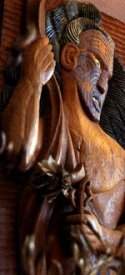|
Search
|
Most Popular

Images above and below:
Called "Tanemahuta", this carving was created by Sonny Taehakoa Witeri.
It is a modern and futuristic example that uses Ta Moko (tattooing) to imbed the symbolic imagery of Tanemahuta, the "God of the Forest".
In addition to whakairo (carving), stone work and joinery techniques have been used to create movement and form.

Image below:
This is a personal adornment called a "heru" and was created by Leslie Rea Stewart.
Ancient Maori would bind their hair into a top-knot, whihc may have taken hours to create.
The highlight of the process was the placing of the heru into the dominant part of the Top-knot.


Waka Shelter, Wairaka, Whakatane
Awa River When Maori introduce themselves formally they will usually name their mountain and their river as an extension of their tribal identification. If you stay on a Marae, you may wish to introduce yourself in the same way.
Awhina Help or assistance
Awhinatanga Traditional Maori custom of caring for others.
Haka A fierce, rhythmical dance accompanied by threatening gestures and grimaces. The most famous haka, of course is the one performed by the New Zealand All Black rugby team at international games called Ka Mate. But Maori do not confine waiata to large public events like this – their waiata and haka are a central part of their culture and are performed whenever people come together. Each tribe has its own haka. The haka originated as a challenge to the approach of strangers, and is part of a rich protocol of encounter, whether in battle or friendship.
The Haka - Ka Mate was first uttered by the famous Maori chief Te Rauparaha who escaped from his pursuers by hiding in a kumara pit. When the hairy local chief who had hidden him opened up the pit, Te Rauparaha was expecting to meet his enemies. He climbed out of the pit and commenced his haka:
Ka mate, ka mate it is death, it is death)
Ka ora, ka ora. (It is life it is life)
Tenei te tangat apuhuruhuru (Behold the hairy man)
Nana nei I tiki mai I Whakawhiti te ra (Who caused the sun to shine)
Upane, upane (Abreast, keep abreast)
Upane ka aupane (The rank, hold fast)
Whiti te ra (Into the sunshine).
Hangi A traditional earth-oven used for feasts and large public events.
Hapu Extended family group
Hongi The traditional personal greeting in a powhiri that involves a pressing of noses or sharing of breath between manuhiri (visitors) and tangata whenua (hosts). The hongi is the traditional form of Maori greeting, much as Europeans shake hands.
Hui Meeting
Iwi Tribal group
Kaitiakitanga Stewardship. Maori believe that they have a sacred duty, handed down from their ancestors to take care of the environment for future generations. Their tikanga lays down specific rules or codes of behaviour for this task – like issues of “resting” fishing grounds and shellfish beds by imposing ceremonial rahui (prohibitions) at certain periods. According to their belief, it is not possible for them to avoid or relinquish this duty, since it is tapu.
Karakia Prayer Like most other indigenous peoples, Maori were and are a very spiritual. Much like, for instance, Native Americans, they considered the world and everything in it to be sacred, and to be possessed of wairua (spirit). In prayer through karakia, Maori connect to this universal spirit as it manifests in the natural world.
Karanga The spine-tingling call made by an elderly woman to call visitors onto a Marae.
Kaumatua Respected male elder
Koha A small gift or donation given as a way of defraying hospitality expenses and as a mark of appreciation for manaakitanga. It is customary to contribute a koha at a Marae visit. One of the manuhiri (visitors) will usually collect the donations prior to entering the Marae and put them in an envelope to be placed on the ground at the end of the whaikorero. Koha used to be given in the form of food – kumara, pigs, etc. but in a cash economy these trasditions have been replaced by the donation of money.
Kotahitanga Unity or oneness, solidarity
Kotiro Girl
Kowhaiwhai Kowhaiwhai are the painted patterns on rafters in a meeting house.
Kuia Respected female elder.
Mana Status, prestige, power, integrity.
Manakitanga Hospitality
Manawhenua The state or responsibility of having guardianship or authority (kaitiakitanga) over a place. Tangata whenua have manawhenua over a rohe.
Manuhiri Guests
Maori Literally – ordinary. Maori (as we now know them) did not exist as a class of people. They were tribal. There were (and still are) different tribal groupings - Tainui, Te Arawa, Ngati Awa, Nga Puhi, Ngati Purou etc. Their constitutional forms were exercised at the Iwi or Hapu level. When Europeans first arrived in Aotearoa they asked the indigenous people here who they were. They replied that they were “just ordinary people” ie. Maori. The name stuck, and as time progressed, the notion of Maori as The Other to the tauiwi (newcomers) became a mark of identity. Yet even today, the struggle to reassert traditional constitutional authority persists, especially with respect to Treaty of Waitangi settlements.
Maoritanga Maori culture
Marae The cluster of buildings and spaces where ceremonial meetings and events happen.
Maraeatea The open space in front of a Whare Nui (Meeting House) which manuhiri (visitors) cross in the welcoming ceremony.
Matua Father
Maunga Mountain. When Maori introduce themselves formally they will usually name their mountain and their river as an extension of their tribal identification. If you stay on a Marae, you may wish to introduce yourself in the same way.
Mirimiri Traditional Maori massage, act of encouragement.
Moana Sea
Moko Traditional tattoo, traditionally facial, but also on the back, arms, legs and buttocks. Moko was usually reserved fro those of high rank or status and was not merely decorative. It was and still is emblematic of whakapapa (ancestral lineage). Women traditionally had their lips and chins tattooed. Men, on the other hand had full facial moko and still do. With a full facial moko, one can literally read a person's identity on their face.
Mokopuna Grandchild
Noa Non-sacred. common, profane, opposite of tapu.
Pakeha The Maori name for New Zealanders of European descent.
Papakainga Communally owned residential development.
Poroporoaki Farewell ceremony usually held after a Marae stay.
Powhiri Ceremonial welcome Take a look at the interactive powhiri on the tourism NZ website http://www.newzealand.com/travel/about-nz/culture/powhiri/powhiri-introducti
on.cfm
Ringawera Literally “hot hands”. Refers to the workers in the kitchen or whare kai who prepare the food, wash the dishes etc, for guests.
Rongoa Traditional medicine.
Runanga (Tribal) Council.
Taha Maori Maori discussion or way.
Taiaha Carved ceremonial spear.
Tamahine Daughter
Tamaiti Son
Tane Husband, Man.
Tangata whenua Literally, ‘people of the land’. Refers to the social group that possesses manawhenua (authority or ownership) over a particular place.
Tangihanga (Tangi) Burial ceremony. Maori ceremonies around death are very important. The mate or dead person or his or her tupapaku (lifeless body) are kept on the Marae for up to three days (depending on the importance of the person in the community) to allow mourners to come to pay their respects. Maori believe that the spirit does not leave the vicinity of the body immediately, and so the tangi is an opportunity for public grieving in which mourners speak directly and publicly to the mate (and sometimes hongi with the tupapaku), and use the event as an opportunity to say goodbye and to move on. It is a profoundly transformative ritual.
Tapu Sacred, dangerous.
Tauiwi New-comers, including Pakeha.
Tautoko Support, urge on.
Teina Younger relation or sibling.
Tikanga Custom, protocol.
Tino Rangatiratanga Maori self-determination. A philosophical and political movement among Maori for their understanding of the Treaty of Waitangi to be honoured. They hold that under International Law, any linguistic variation in Treaties or Agreements between the colonial powers and indigenous peoples must favour the Treaty version written and signed by the colonised in their own language. In this light, Tinorangatiratanga is seen for a call to equality of partnership and a reinstatement of self-determination by Maori.
Tohunga Expert, master in a given field ie. Tohunga Whakairo – master carver.
Tuakana Older relation or sibling.
Tuakana – Teina The Maori tradition whereby older children take care of, protect and teach younger siblings.
Tipuna Ancestor
Turangawaewae Literally, ‘place to stand’. Refers to the place where one is born or with which one identifies culturally and ancestrally. In formal situations it is traditional for Maori to introduce not only themselves by name, but also to name their river, their mountain, their lake etc. This comes from a time when it was a matter of survival to know not only who a person was as an individual, but where they were from both geographically and ancestrally. Utu the code of reciprocity and/or revenge had no time frame, and historical obligations either positive or negative needed to be specifically understood. It is also the name of the place in the Waikato region which is the traditional seat of the Kingitanga Movement - the seat of the Maori King or Queen.
Uri Descendants
Urupa Cemetery or burial ground. Note that most Maori burial grounds have water available at the entrance/exit. This is to sprinkle on oneself after visiting the dead, to remove the tapu associated with death.
Utu Custom of reciprocity or payback. Sometimes refers to revenge, but utu was and is a very basic cultural standard of Maori, who were very concerned to not be seen to be exploiting others. Utu is closely linked to manakitanga or the rules and customs of hospitality.
Take Purpose – as in the purpose of a Marae visit.
Waharoa The gateway that usually separates a Marae or pa (village) from the rest of the world. It marks the entrance transition point from profane or common space into sacred space – the Marae Atea.
Wahine Woman, wife.
Waiata Song or chant.
Wairua Spirit
Waitangi Place in the Bay of Islands where the Treaty between the British and Maori was signed in 1840.
Waka Canoe. In modern usage it is used to refer to an automobile. Sometimes used as a term for a confederation of tribes whose tupuna (shared) ancestors arrived on the same waka from the Pacific Islands at the time of migration, as in Mataatua Waka.
Wero The traditional challenge component of a powhiri.
Whaia Mother
Whaikorero The (often long) ritual of reciprocal speech-making that forms a central part of a powhiri.
Whakairo Carving, usually of a building or building component. Carvings are not merely decorative, but tell the story of the ancestor whom the house represents, and of the people who occupy it.
Whakaiti Humble. Literally, ‘to make oneself little’. Persons who have this characteristic are most highly valued in Maori culture.
Whakapapa Genealogy
Whanau Immediate family
Whare House
Whare Kai Communal dining room or building.
Whare Nui Ceremonial Meeting House, literally ‘big house’. Sometimes called a Whare Hui (literally ‘meeting house’, or Whare Moe (Sleeping house – since Maori hui or meetings often go on for days and people sleep communally over extended periods. The wharenui is seen as the embodiment of an ancestor – the ridge being the spine, the rafters the ribs, the koruru (carved face at the apex of the front maihi (bargeboards) etc.
Whare Paku Toilet
Whare Rapuora Maori Health Centre. Sometimes called a Whare Hauora. (Wind, essence or breath of life).
Whare Waka A ceremonial canoe shelter. In modern usage, a garage.
Whare Wananga Traditional place of esoteric learning.

